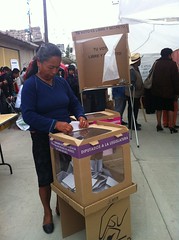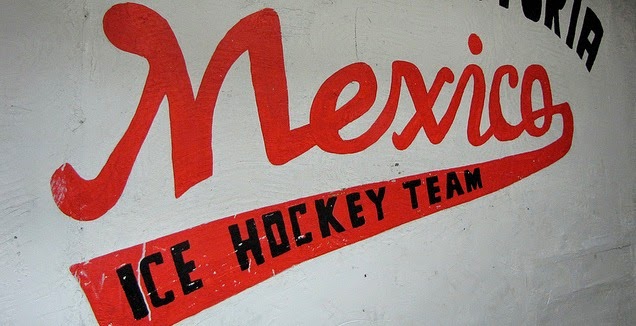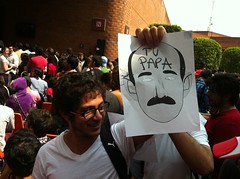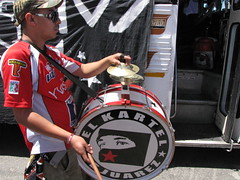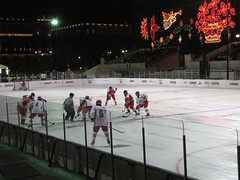
WINNERS
ENRIQUE PEÑA NIETO
The Institutional Revolutionary Party (PRI) candidate entered the debate with a 20-point lead and nothing happened to impact that, even though he took repeated shots from from his two main opponents.
He left many of his thoughts on serious matters unfinished, said political science professor Aldo Muñoz Armenta of the Autonomous University of Mexico State, but none of that will hurt Peña Nieto since he adequately defended himself and had no major gaffes.
In effect: Peña Nieto wins the debate by not losing and his 20-point lead should remain in tact, Muñoz said.
A poll from El Universal gave him the win in the debate – with Andrés Manuel López Obrador, representing three left-wing parties, finishing second; Gabriel Quadri of the New Alliance placing third and Josefina Vázquez Mota of the governing National Action Party (PAN) bringing up the rear.
Anyone looking for gaffes or a repeat of the Guadalajara International Book Fair fiasco – when he couldn't name three books – was undoubtedly disappointed. The amateur hour antics of the pre-campaign period appear to be history. Somebody from the PRI campaign presumably changed the password on his daughter's Twitter account to prevent intemperate tweets, too.
Peña Nieto came in well-coached and while not especially smooth, again, his performance was sufficient.
Peña Nieto's defence of his 2005-2011 term in Mexico state seemed adequate, if not entirely convincing – although enough Mexican voters really do seem convinced that he really did complete the 608 public works projects that he's built his campaign platform on. Just don't ask anyone at a PRI rally try naming one – they usually can't.
Attempts by opponents to revive the memories of PRI dinosaurs seemed to have little impact, too.
If this synopsis seems boring, that's because Peña Nieto's performance was boring – and that's okay for him: it keeps him in the lead by a large margin.
GABRIEL QUADRI
The New Alliance party candidate had nowhere to go, but up – and he soared. He spoke directly and on the issues. He challenged his rivals over policy issues – such as energy subsidies, over which he disagreed with López Obrador – and even chastised the other candidates crushing disinterest in the environment (his main cause) by taking the segment on that topic to attack each other.
Quadri only needs two percent of the vote for the New Alliance to maintain its registration. His strong campaign performance all but assures that. The Quadri campaign now moves from being novelty news – the unveiling of the Quadri combi; his complaining about the bulletproof Volkswagen Jetta given to him by presidential security; no one appearing when he spoke at the World Economic Forum, to name three headlines – to someone to be taken halfway serious. Of course, there's no hope in hell of him winning the election. He might make a good environment minister in a PRI government, though.
If there's a flaw with Quadri, it's his party affiliation
The New Alliance does the political bidding for thew SNTE teachers' union and its boss Elba Esther Gordillo. She effectively owns the New Alliance and assigns its candidacies to her children and grandchildren.
To paraphrase what a friend tweeted during the debate: Quadri is turning in a strong performance, but his party ...
ELBA ESTHER GORDILLO
Thanks to Quadri's performance, the New Alliance should obtain the two-percent of the vote necessary for maintaining its registration. This means collecting a share of the more than $3 billion in public subsidies showered on political parties by the Federal Electoral Institute (IFE) over the past 12 years. It also means having political positions for SNTE boss Elba Esther Gordillo to give her children and relatives. Daughter Mónica Arriola and son-in-law Fernando González are running for Senate seats in Chiapas and Sinaloa respectively. A grandson is running for the Mexico City Assembly.
Gordillo's kin might have had a better shot of being elected had the New Alliance-PRI electoral alliance not unravelled due to priístas (mostly in states without a sitting PRI governor to impose order) revolting against the handing over of too many candidacies to a junior partner. Quadri's improving candidacy makes that history moot, although the Muñoz, the political science professor and labour expert, says the teachers are deft political operators and make deals to swing local races in favour of whatever candidate suits their purposes.
THE EDECÁN
The model with the cards, deciding the order the candidates would speak in, stole the show – or, more aptly, her revealing attire did, or, as the AP put it: no one was looking at the urn she was carrying. Certainly Quadri wasn't looking at the urn. As a female friend quipped on Facebook, under a photo of the model: They're more fake than the candidates.
Julia Orayen has posed for playboy and now has a new lease on her modelling life thanks to whoever hired her (apparently an IFE contractor) to work a supposedly serious political function while wearing that dress.
PERFORMED WELL
ANDRÉS MANUEL LÓPEZ OBRADOR
AMLO came out with guns blazing, even though he's been speaking of peace and love during his campaign. He invoked characters from the distant past such as General Antonio López de Santa Anna, who was president of Mexico 11 times during his calamitous career. More recent characters included former president Carlos Salinas de Gortari, a favourite whipping boy of non-PRI politicians, and Arturo Montiel, Peña Nieto's predecessor and former boss in the Mexico state governor's office.
Political analyst Fernando Dworak said AMLO had a discourse still stuck in the 1990s. That was especially obvious when AMLO brought up the scandalous banking bailout Fobaproa.
Invoking Salinas and Fobaproa incited outrage the first time López Obrador ran for president in 2006, but it would seem less so now. Equally uncertain is the impact of López Obrador alleging that the broadcasting industry is imposing its candidate (Peña Nieto) on the country or his railing against the country's privileged elite. (Even if he's correct.)
He delivered the exchange of the night. When Peña Nieto countered allegations made against PRI dinosaurs by bringing up the case of René Bejarando – the ace DF organizer caught stuffing bills into a briefcase – AMLO responded: Bejarano went to jail, unlike any priístas.
His performance makes it likely that he'll overtake ...
LOSERS
JOSEFINA VÁZQUEZ MOTA
The PAN candidate bet heavily on the debate rescuing her campaign. Given those kinds of stakes, she fell short in the debate, even though some in an audience convened by the Reforma newspaper ranked her highly – drawing ridicule from Twitter users about what debate they were watching.
Like AMLO, she went on the attack. She brought up the Coahuila debt situation. She brought up the Mexico state debt – something Peña Nieto refuted. She also brought up the fib from Peña Nieto's informe (state-of-the-state address) that the homicide rate fell 50% in Mexico state between 2005 and 2010. (Peña Nieto has since retracted the claim.)
But it's uncertain if going negative has helped Vázquez Mota so far in the campaign – and it's unlikely going negative in the debates will help any more. She appeared stiff during the debate and clumsily moved to address topics she felt important – such as her carrying on about Pemex and the CFE near the end.
Her campaign needed a miracle – which former President Vicente Fox said was necessary and in which he believes. It didn't arrive last night.
